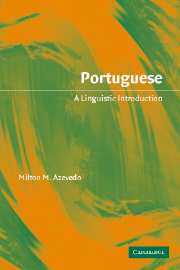Book contents
- Frontmatter
- Contents
- List of maps
- List of tables and figure
- Acknowledgments
- List of abbreviations and symbols
- Introduction
- 1 The Portuguese language in the world
- 2 Sounds
- 3 Words
- 4 Sentences
- 5 Portuguese in time
- 6 The expansion of European Portuguese
- 7 Brazilian Portuguese
- 8 Sociolinguistic issues
- Suggestions for further reading
- Glossary
- Bibliography
- Index
7 - Brazilian Portuguese
Published online by Cambridge University Press: 05 September 2012
- Frontmatter
- Contents
- List of maps
- List of tables and figure
- Acknowledgments
- List of abbreviations and symbols
- Introduction
- 1 The Portuguese language in the world
- 2 Sounds
- 3 Words
- 4 Sentences
- 5 Portuguese in time
- 6 The expansion of European Portuguese
- 7 Brazilian Portuguese
- 8 Sociolinguistic issues
- Suggestions for further reading
- Glossary
- Bibliography
- Index
Summary
Like any language spread over a large territory occupied by a stratified society, Portuguese as spoken in Brazil encompasses a raft of partially overlapping regional and social varieties that show a significant amount of contrast in pronunciation and syntax. The present chapter will review some of the specific features of Brazilian Portuguese.
Variation in Brazilian Portuguese
A great deal of such variation is directly related to speakers' educational level, which in turn is linked to their socioeconomic situation. In fact, some of the most salient contrasts within Brazilian Portuguese are not regional but social. There is considerable divergence between the vernacular° speech of the majority of the population, the speech of the educated minority, and the normative° language codified in prescriptive° grammars. Traditionally, such grammars have been based primarily, if not exclusively, on the formal written usage found in Portuguese (and, as of the 1920s, also Brazilian) literary works spanning over four centuries. In principle, there is nothing wrong with this, for it is necessary to have reliable descriptions of the language used in literature. The error, however, has consisted in taking the literary variety as being the only valid one, and in condemning varieties diverging from it – such as the vernacular – as the result of decay caused by speakers' poor language habits. In addition, it has been determined that poor theoretical principles and unsystematic selection of examples have led normative grammars to contradict each other (Castilho 1989a:57).
- Type
- Chapter
- Information
- PortugueseA Linguistic Introduction, pp. 211 - 255Publisher: Cambridge University PressPrint publication year: 2005



